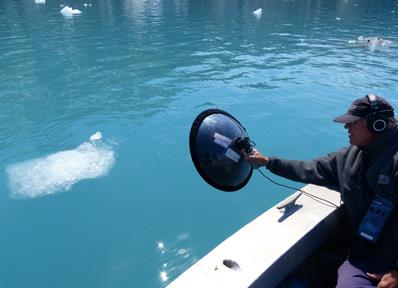What are some of the most interesting natural sounds in Glacier Bay?
Project Dates
May 2013 - December 2014
Did You Know?
Thrushes and other songbirds continue singing right through a thunderstorm.
Introduction

As a society, we are traditionally focused on the visual aspects of our natural environment, so our most famous national parks are those with the most spectacular scenery and conspicuous wildlife. In recent years, however, there has been an upsurge of interest in the auditory aspects of wild nature, including both the sounds and the silence. Original voices and wild choruses are among the most precious elements of our wilderness heritage.
National parks are the most important repositories in which these voices can be preserved for generations beyond our own. In Alaska, Glacier Bay National Park and Preserve may be the premier location, offering the greatest richness and variety of wild voices, from calving glaciers and crashing surf, to hermit thrushes and humpback whales.
This project aims to produce a comprehensive interactive library of natural sounds recorded within Glacier Bay National Park and Preserve, including the biological and physical environment, as well as sounds produced by visitors and other human activities. The project will produce a baseline archive of natural acoustics, beginning in 2013. By the end of its first year, the Glacier Bay Natural Sounds Library may contain a thousand or more individual audio tracks. These sounds will be valuable for interpretive programs, multimedia projects, website pages, naturalist and researcher training, and scientific studies.
Methods
Recording techniques, data collection/entry, and archival procedures have been developed in consultation with staff at the Macaulay Natural Sounds Library at Cornell University and the NPS Natural Sounds Program in Ft. Collins, Colorado. This project will utilize equipment and protocols that are the “gold standards” in the field.
Supportive data will be compiled for each track, including GPS location, date and time, weather conditions, habitat information, and other circumstances that could affect a recording or subsequent analysis.
All recordings will be archived at the Macaulay Library; a high-resolution copy will also be maintained onsite at park headquarters.
Findings

Highlight recordings include seabirds, Steller sea lions, thunder, humpback whales (both beneath and above the water), melting and moving glacial ice, howling wolves, and a variety of songbirds.
Learn More
Follow Hank Lentfer’s blog at:
http://www.orionmagazine.org/index.php/newsfrom187/cat/C324/
Last updated: October 26, 2021
